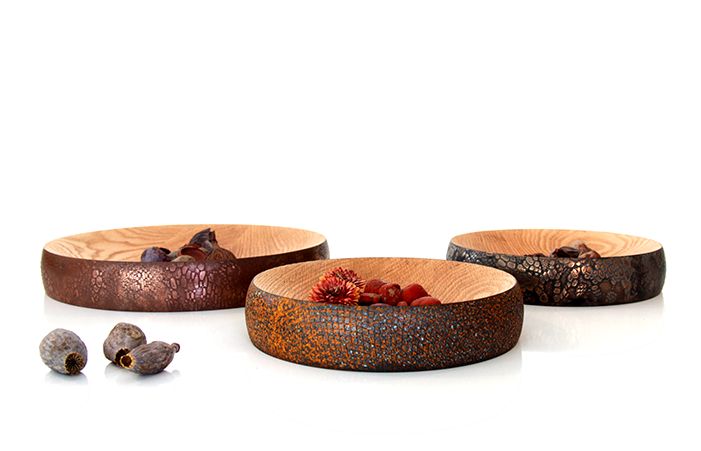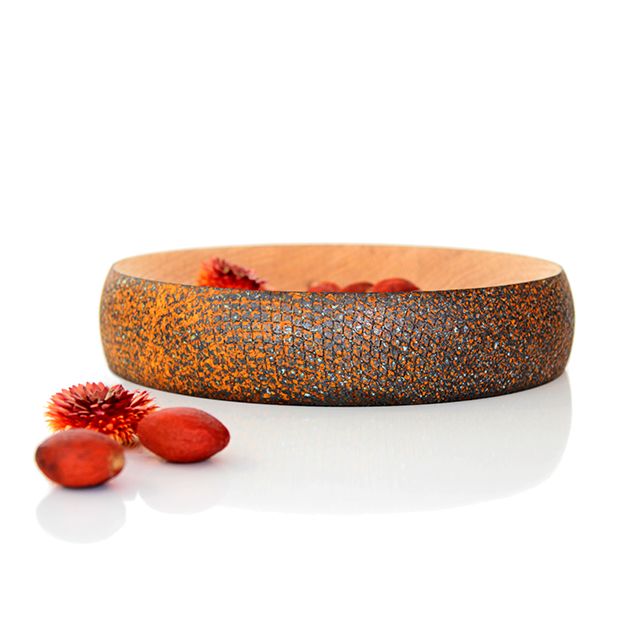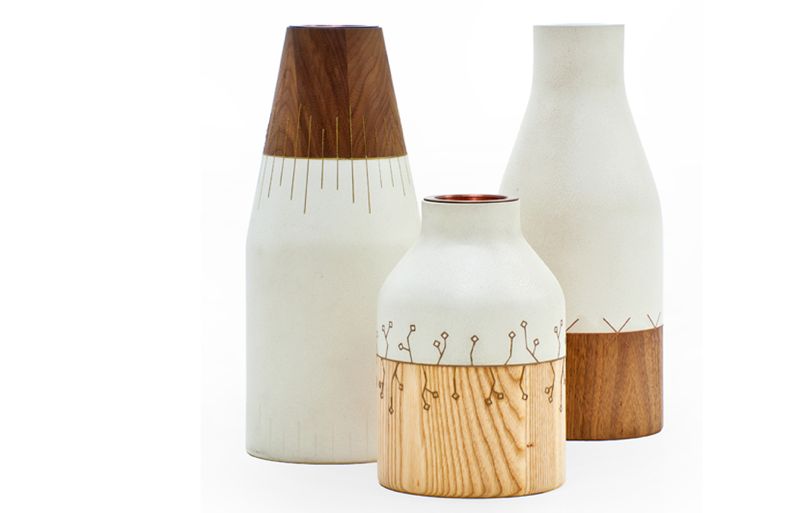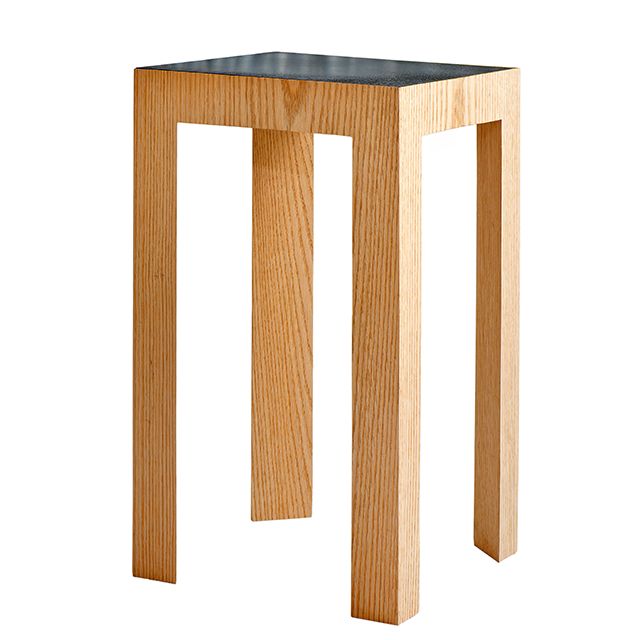The second in a four-part series on new Australian Furniture brands.
Launched in October 2013, Anomaly is a joint venture by two established Sydney companies, Axolotl and Evostyle. The new brand was set up specifically to fill the gaping hole in the Australian furniture market for design-led Australian made items but also as a way to make full use of Axolotl’s innovative surface finishes in the furniture sector. With three decades of experience in joinery and wood turning, Evostyle, led by Luke and Louise Ommundson, provides the manufacturing know-how and facilities to produce the furniture pieces. Axolotl’s expertise in lightweight metal, glass and concrete finishes allow for a host of exotic surface treatments that combine metals or concrete with various woods. Complex textures are also possible such as a metallic snakeskin or braille-like raised metal surfaces.
The intention of the brand is to give each object a level of character that is so often missing from mass-produced furniture and related interior objects. All the collection is proudly Australian designed and manufactured with the design skills being supplied by David Caon, Philip Chia, Adam Cornish, David Knott, Facet Studio, Matthew Sheargold and Ben Wahrlich. More new releases by both emerging and established designers are planned over the next 12 months.
"We got together to create furniture with a real point of difference. We're trying to get away from that manufactured look and to come up with something that looks handcrafted".
Kris Torma, co-founder, Anomaly
The ‘Zig’ cabinets and credenzas of Ben Wahrlich are made from concrete ‘slate’ and American oak. The concrete shell houses fluted timber drawer fronts and sliding doors, whose design is derived from the way in technical drawings, 3-D objects are shown with cross hatching to differentiate one surface from the next. ‘Zig’ adopts this idea by featuring a different hatch direction for each drawer or door, creating a highly textural form within the smooth concrete box. Wahrlich also contributed the ‘Kodiak’ bowl to the collection. Available in three finishes, ‘Kodiak’ is a shallow turned timber bowl that can feature either an Axolotl 'Viper' or 'Cayman' metal texture on its exterior surface.
While some of the designers are young and up-and-coming like Wahrlich, others are veterans of the Australian design scene. Matthew Sheargold whose 'Kintsugi' vessels form part of Anomaly's debut collection, has balanced his design practice between interior design, product and furniture design for the past 17 years. He currently runs SHEARGOLD, a multi-disciplinary design firm based in Sydney and has a number of his furniture designs in production with Australian manufacturer, Woodmark.
David Caon contributes several pieces to the Anomaly collection with two tables, a dining chair, an armchair and a floor standing mirror. Caon's ‘Ghillie’ range of chairs are available as plain timber pieces or with applied finishes to the seat and/ or back. The current designs include the metallic camouflage-like ‘Camo’ in copper and concrete, the graphic ‘Skull’ executed in brass and ‘Vector’ which involves contrasting patterns of fine brass lines. Caon’s intention is that the ‘Ghille’ chair is treated as a blank canvas, with buyers able to specify their own unique designs in a range of finishes. The basic chair is in solid American Oak while all the other variations are textural, rising one to two millimeters off the surface. Caon is one of a recent wave of Australian designers who have sought experience abroad before returning to continue their work at home. Having worked with some exceptionally talented designers and studios such as George Sowden, Jerszy Seymour and Marc Newson, Caon became Design Leader for prestigious international architectural firm Woods Bagot in 2007 and has been billed as one of Australia’s top 10 emerging designers.
In stark contrast to the other designs in the collection, Adam Cornish and David Knott's 'Elements' range is a simple production solution with very little attention given to any form of decoration. The table, stool and bench revolve around a clever metal casting that allows for simple triangulation of the turned legs. Cornish is Melbourne based while Knott lives in Sydney but the two designers shared such a level of synergy on this, their first joint project, that the design evolved from initial discussions via Skype to working prototypes in a matter of just a few weeks. The result has a pleasingly agricultural feel courtesy of the sand-cast aluminium joint and solid timber elements that use minimal shaping. Cornish feels that the differences in their approach to solving design problems enabled everything to be worked out in record time, with each designer acknowledging the other's experience and strengths in different areas. A collaboration to be repeated.
Another of the contributors to the first Anomaly collection are Facet Studio, a multi-disciplined practice founded by Olivia Shih and Yoshihito Kashiwagi in 2008. Their 'Coexistence' range of a dining table, coffee table and side table, uses oak plywood in conjunction with concrete 'slate' to create an archetypal table shape with a subtle triangular leg.
Lighting products by both Andy Grigo and Ben Wahrlich are planned for release in the near future. The 'Glide' pendant light by Andy Grigor uses a simple fold of powder-coated metal that drapes over a timber pole - much like a sheet of paper over a pencil. The airborne motif is slightly humorous but genuinely light in appearance and with undeniable charm. Available as a single suspension or a as a long beam with three fittings, it will be joined by Wahrlich's upturned vase style pendant turned from solid American oak.
What is clear from the collection is that the unique combination of Axolotl and Evostyle has resulted in a courageous attempt to open up the Australian furniture sector to new ideas and materials as well as groundbreaking surface treatments. While the collection is a little stylistically schizophrenic at times, it's an amazing first attempt at bringing ten Australian designers under the same brand and will undoubtedly find it's feet as the collection grows. For more information go to the Anomaly website.
















